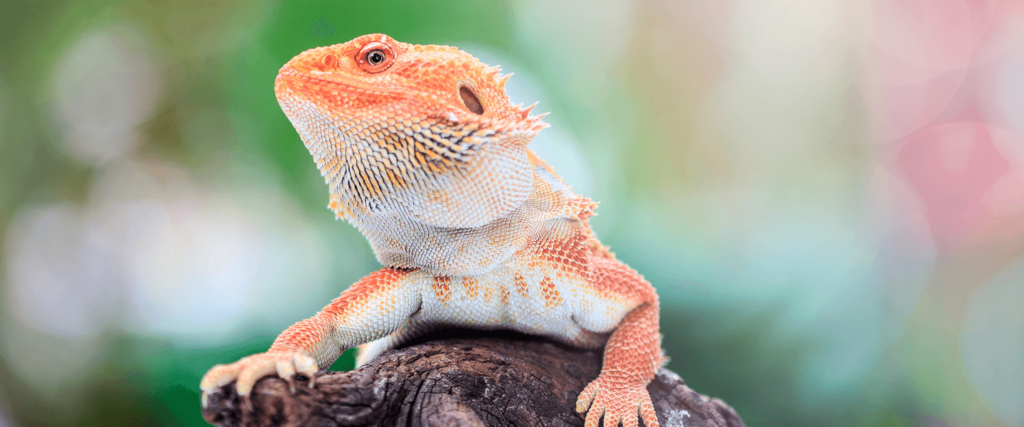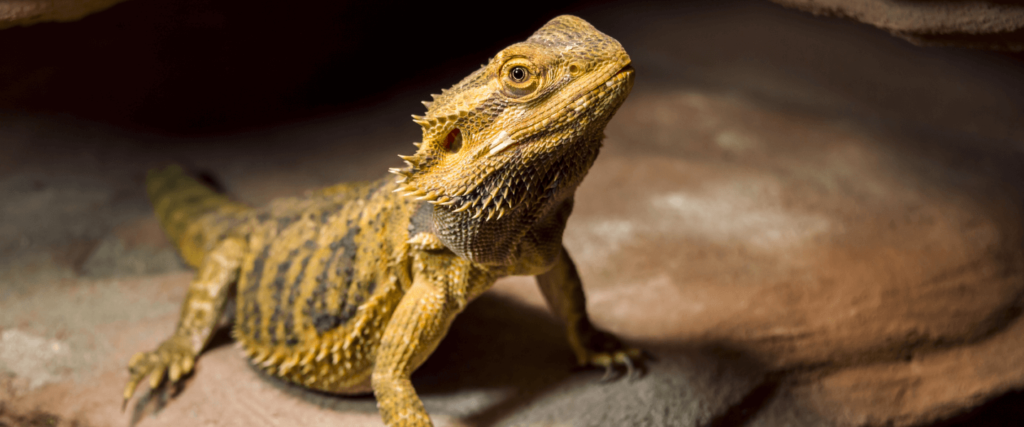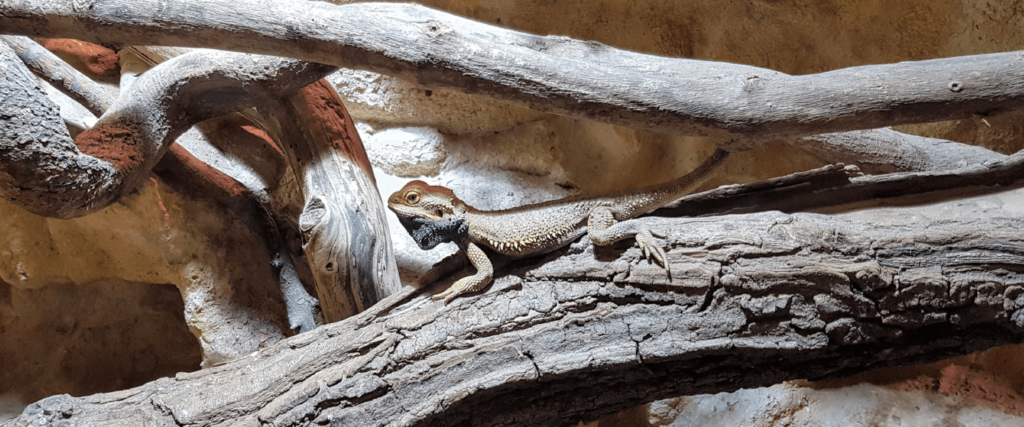Optional extras
Bearded dragon, Pogona vitticeps, care sheet
Categories: Care sheetsLizards
Bearded dragon natural history
Bearded dragons are an entire genus (Pogona) of 6 Australian lizard species, however, in the exotic pet trade, we usually refer to a single species as the 'Bearded dragon', which is the Central or Inland bearded dragon (Pogona vitticeps) hailing from, you guessed it, Central Australia.
Other species include the popular Rankin's dragon (Pogona henrylawsonii), the Eastern bearded dragon (Pogona barbata), the Kimberley or Drysdale river bearded dragon (Pogona microlepidota), the Western bearded dragon (Pogona minor), and the Nullarbor bearded dragon (Pogona nullarbor). For the sake of this Bearded dragon care sheet, however, we will focus on the Central bearded dragon, as this is the species most commonly kept in the hobby.
Bearded dragons can reach around 60cm (24") in length, with their long tail accounting for roughly half of this length. They naturally vary in colour, exhibiting hues of brown, reddish-brown, yellow, orange and white, although a wide variety of artificially selected colour morphs also exist in the hobby, one of the most interesting being the paradox morph, which as a plain colouration with vibrant blotches of colour along the body, similar to paint splatter.
Bearded dragons have a few interesting adaptations, gained over years and years of natural selection, to help them survive in their harsh natural habitat. These include an inverted head that allows water to form droplets that drip straight into their mouths, a third eye in the top of their head to help them sense avian predators, they can burrow underground to escape the extreme heat of the Australian outback and are one of few reptiles to exhibit social learning in the form of imitation.

Bearded dragon housing
Due to their larger size and high activity levels, Bearded dragons should be provided with enough room to thermoregulate, explore and provide enrichment. In nature, they can often be found resting on low branches, so their enclosure should also incorporate a little height, allowing you to provide them with some branches and perches, more closely replicating their natural habitat.
For adult dragons, the minimum recommended enclosure size is 120 x 60 x 60cm (4 x 2 x 2ft), although bigger is always better, so if you have the space and budget to go larger for your Beardie, they will certainly appreciate it. A young Bearded dragon can be kept in a slightly smaller enclosure, although this tends to increase costs in the long run, as eventually, as your dragon grows, the enclosure will need to be upgraded.
Bearded dragons are a highly territorial species, particularly males, so should never be kept in pairs or groups, as this will often lead to fights and injuries. Along with this, the enclosure requirements to house more than one Bearded dragon would be unrealistic for most hobbyists, even without their territorial nature.
To make things easier, why not take a look through our Bearded dragon starter kits, rated for juveniles or adults, and get everything you need in one go, if you're not sure which starter kit to choose, take a look at our help guide on selecting the right Bearded dragon starter kit.
Bearded dragon heating
The ideal temperature range for Bearded dragons is around 40-42°C (104-107°F) in their basking spot/hot end, and the cool side sitting somewhere around 25°C (77°F). This should be achieved using an overhead heating system, such as a basking lamp or a ceramic heat emitter hooked up to a compatible thermostat (dimming for a basking lamp, pulse for a ceramic).
Heat mats should be avoided for Bearded dragons, as they do not tend to produce near enough heat to warm the ambient air temperature in the set-up to the required levels.
Bearded dragons do not, in most instances, require nighttime heating, unless the ambient temperature of the room they are kept in drops below around 15°C (59°F). Allowing this nighttime temperature drop is actually much more natural for them, as it more closely resembles the temperature changes in their natural environment. If overnight heating is required, this should be provided using a non-light emitting heat source such as a ceramic heater, so as not to disturb your Beardies sleep-wake cycle.
It is important to use two accurate thermometers to monitor the temperature on both the hot and cool side to ensure the temperatures remain within the optimum range, and to help identify any potential faults with heating equipment.
To learn more about Bearded dragon heating, check out our dedicated Bearded dragon heating help guide.

Bearded dragon lighting
Bearded dragons require a high output UVB light to allow them to metabolise vitamin D3 and, in turn, properly assimilate the calcium provided in their diet, preventing serious health issues such as metabolic bone disease. This is best achieved using a T5 UVB bulb, the strength of which should be tailored to the distance between the UVB bulb itself and the Bearded dragons highest basking spot.
If this distance will be between 25-30cm (10-12"), a 6% T5 bulb will suffice, if the distance will be between 30-45cm (12-18"), a 12% T5 bulb should be used, whereas if this distance will be greater, but no greater than 60cm (24"), then a 14% T5 bulb is required.
All UV lights have a limited lifespan before they cease to emit adequate UVB, although they will likely still be emitting visible light (UVA) beyond this point. For T5 bulbs, this lifespan is estimated to be around 12 months, so the tubes should be switched out once annually. You could also use a Solarmeter to monitor the UVB given off, and only replace the bulb when this becomes inadequate.
Bearded dragon humidity
Bearded dragons have low humidity requirements, with their ideal range sitting between 30-40%, which is a little lower than the average room humidity in the UK (~50%). This means that little needs to be done to achieve this, as the drying heat from your heating equipment will keep the humidity a little lower than the room. To ensure the humidity does not rise too high, keep your water source on the opposite end of the enclosure to the heating equipment, to reduce evaporation.
Bearded dragon substrate
Bearded dragon substrates have been a controversial topic in the hobby. Sand is a natural part of a wild Bearded dragon's habitat, although due to the poor husbandry that was often provided to captive Bearded dragons in the past, many keepers now recommend against the use of sand.
This is mainly due to Bearded dragons suffering from intestinal impaction from the ingestion of sand. However, this usually comes down to improper husbandry, a healthy Bearded dragon will not actively seek nutrition from its substrate when all of its other husbandry requirements are being met, particularly its dietary requirements.
Whereas, a Bearded dragon suffering from malnutrition will seek out what they are missing from wherever they can, including their substrate. Therefore, with correct husbandry, impaction should not be a cause for concern.
Given the above, we recommend high-quality, sandy, loose substrate for Bearded dragons, which more closely replicate their natural environment, and allow them to exhibit natural digging and burrowing behaviours, although non-loose 'substrates' such as tiles or slates can also be used successfully.
We do not recommend using reptile carpet for Bearded dragons, however, as this can often catch the Bearded dragons claws in the fibres, causing injury, and also tends to harbour bacteria despite being 'washable'.
For more detailed information regarding Bearded dragon substrates, why not take a look at our dedicated Bearded dragon substrates help guide.
Bearded dragon diet
One of the most important aspects of Bearded dragon care is their diet. Bearded dragons are omnivorous, so Bearded dragons eat both plant and animal material. Plant material will make up the biggest part of your Bearded dragon's diet and should be fed daily, whereas feeding insects should be kept to 2-3 times per week for adult Bearded dragons, or daily feeding for young Bearded dragons.
The plant part of their diet should be made up of a mixture of leafy greens, such as spring greens and lettuces, vegetables such as peppers and sweet potatoes, and the occasional pieces of fruit as treat.
The animal material part of a Bearded dragon's diet should come from live insects, termed live food, examples include Dubia roaches, crickets, locusts, mealworms and other insects such as wax worms can be fed as treats.
To keep your Bearded dragon healthy, a good, varied diet is not enough in captivity, and their food must be dusted with supplements according to a schedule to ensure they receive all of the required nutrients. This should be a calcium-rich multivitamin on every feed, calcium plus magnesium supplement on every fourth feed, and a vitamin D3 supplement on every eighth feed, before beginning the cycle again.
To learn more about the optimum diet for Bearded dragons, or learn reasons your Bearded dragon might not be eating, take a look at our help guide focused on Bearded dragon diets.

Bearded dragon tank decoration
To provide enrichment and allow your Bearded dragon to thrive, you should provide plenty of semi-arboreal perches in the form of hammocks, branches and basking platforms along the entire length of the vivarium.
Rough pieces of decor, such as wood pieces or rocks will also help to keep your Bearded dragon's claws down, reducing the risk of related health issues.
Hiding areas should be provided along the length of the enclosure, either using logs, half logs or traditional reptile hides. Further decoration can be provided using foliage, which can either come in the form of live plants, such as Aloe vera or Echeveria in a bioactive Bearded dragon setup, or artificial plastic plants.
Without adequate enrichment, a Bearded dragon is likely to become bored and/or stressed, a classic sign of this in Bearded dragons is glass surfing, which essentially means the dragon is lifting up its body against the glass of its vivarium, seeking more space or enrichment. This behaviour alone is not dangerous but signals a wider issue with the Bearded dragon's tank setup that should be addressed to avoid unnecessary stress.
It is also important to provide a shallow water dish on the cool side, away from the basking lamp, to provide hydration without increasing the overall humidity levels, and a shallow food bowl for your Bearded dragon's greens to go in, minimising the risk of substrate ingestion whilst eating.

Bearded dragon breeding
Before considering breeding your Bearded dragon, it is of utmost importance that your dragon is sexually mature and in optimum condition and that you have enough space to house both the male and female separately to the above standards, to house the hatchlings, and have an even larger enclosure to adequately house the pair whilst breeding, they must have the opportunity to escape each other if they feel the need to do so. The pair must also be of similar size to each other.
To ensure your dragons are ready to breed, you should lower the temperatures and reduce daylight hours for a period of two to three months before putting the pair together. Bearded dragons may breed without this brumation period, but their fertility will be reduced and the eggs less likely to survive.
Once the brumation period is completed, you can put the pair together to do the deed. This can get a little rough so it's a good idea to keep a close eye on them, but also not to worry too much as it is natural for the male to grab hold of the female during the process, it can just be a little worrying to first-time breeders.
For more information on Bearded dragon brumation, why not take a look at our dedicated help guide.
Leave the pair together for roughly 7 days before separating them back into their own enclosures, ensuring she has a lay box filled with moist soil, placed in a way that she can easily get into it. She will be ready to lay her eggs in roughly four to six weeks.
Once the eggs have been laid, carefully remove them, ensuring you keep them in the same position they are laid (do not turn them over), and place them into a tray with damp vermiculite, and put this into the incubator at around 28°C (84°F), also maintaining humidity levels between 70-90%. The eggs should then take around 10 weeks to hatch.
Please note, we do not recommend breeding for beginner keepers. The exotic pet market is flooded with reptiles with poor genetics, bred by beginners from animals with underlying genetic issues. Due to this, we recommend avoiding breeding at all costs, unless you are extremely experienced and your animals are in perfect health.
Alternative species
Like the sound of a Bearded dragon but not sure if they're the right pet for you? There are plenty of other reptiles with similar behaviours or care requirements, for example, the slightly smaller Rankin's dragon (Pogona henrylawsonii), which is a species within the Bearded dragon genus (Pogona) and has practically identical care requirements.
Another example would be the Starred agama (Stellagama stellio), which is an Agamid lizard, like Bearded dragons, and has similar care requirements, but is a little less common in the pet trade and poses more of a challenge when it comes to taming them down. Some snakes are also suitable alternatives, such as the Western hognose snake.
If a Bearded dragon sounds like the perfect pet for you, why not check if we have any in stock, or even contact our store team to discuss the details and find the right Bearded dragon for you.
Bearded dragon care at a glance
Common names: Bearded dragon, Beardie, Central bearded dragon, Inland bearded dragon
Scientific name: Pogona vitticeps
Country: Australia
Captive-bred: Yes
Adult size: 61cm (2ft)
Natural habitat: Arid woodland, scrub, grassland and desert habitats
Housing: 120 x 60 x 60cm (4 x 2 x 2ft)
Ideal temperature: 40-42°C (104-107°F) (warm end); 25°C (77°F) (cool end)
UVI: 4-6
Ideal humidity: 30-40%
Diet: Omnivorous
Average lifespan: 10-15 years
Personality: Docile
Ease of handling: Easy
Cohabitable: No
Bearded dragon shopping list
- 120 x 60 x 60cm vivarium (minimum)
- Heat lamp fixture
- Basking lamp or ceramic heater
- High range thermostat (dimming or pulse depending on heat source)
- T5 lighting kit
- Digital thermometer x2
- Water dish
- Food dish
- Substrate
- Hides and decor
- Supplements (multivitamin, calcium + mg and D3)
- Reptile safe disinfectant
While you're thinking about caring for your new Bearded dragon, why not take a look through our range of Bearded Dragon Starter Kits? Designed so that you can get everything you need to get started in one go, at a great price!
Becky Bates has always had a fascination with animals, particularly reptiles, amphibians, and invertebrates from a young age. A graduate of Zoology, she is a dedicated and experienced reptile keeper providing top-notch advice and care to Swell Reptiles customers. With her extensive experience with animal biology and behaviour, she understands the importance of promoting a healthy, safe, and happy environment for all animals.










